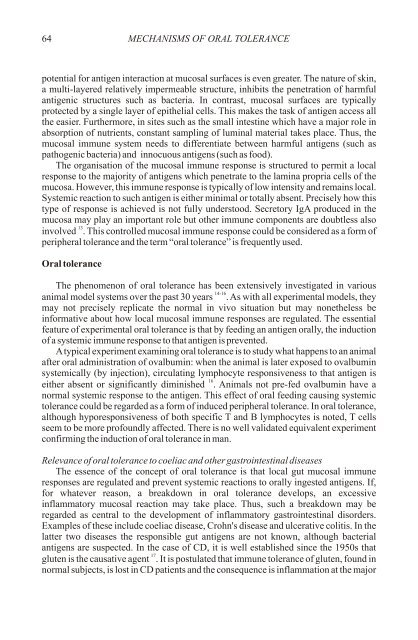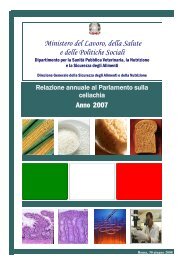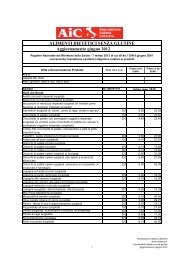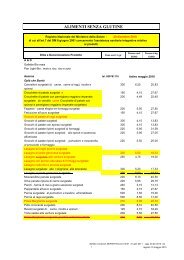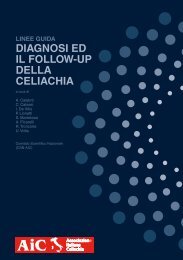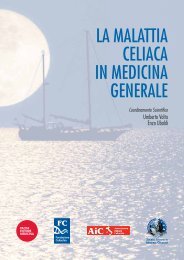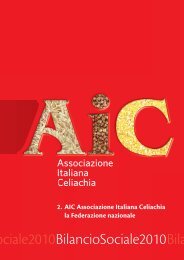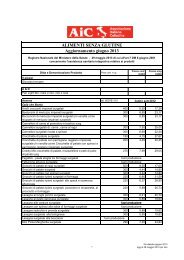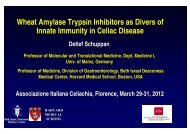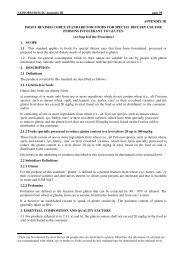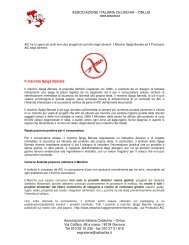primary prevention of coeliac disease - Associazione Italiana ...
primary prevention of coeliac disease - Associazione Italiana ...
primary prevention of coeliac disease - Associazione Italiana ...
You also want an ePaper? Increase the reach of your titles
YUMPU automatically turns print PDFs into web optimized ePapers that Google loves.
64 MECHANISMS OF ORAL TOLERANCE<br />
potential for antigen interaction at mucosal surfaces is even greater. The nature <strong>of</strong> skin,<br />
a multi-layered relatively impermeable structure, inhibits the penetration <strong>of</strong> harmful<br />
antigenic structures such as bacteria. In contrast, mucosal surfaces are typically<br />
protected by a single layer <strong>of</strong> epithelial cells. This makes the task <strong>of</strong> antigen access all<br />
the easier. Furthermore, in sites such as the small intestine which have a major role in<br />
absorption <strong>of</strong> nutrients, constant sampling <strong>of</strong> luminal material takes place. Thus, the<br />
mucosal immune system needs to differentiate between harmful antigens (such as<br />
pathogenic bacteria) and innocuous antigens (such as food).<br />
The organisation <strong>of</strong> the mucosal immune response is structured to permit a local<br />
response to the majority <strong>of</strong> antigens which penetrate to the lamina propria cells <strong>of</strong> the<br />
mucosa. However, this immune response is typically <strong>of</strong> low intensity and remains local.<br />
Systemic reaction to such antigen is either minimal or totally absent. Precisely how this<br />
type <strong>of</strong> response is achieved is not fully understood. Secretory IgA produced in the<br />
mucosa may play an important role but other immune components are doubtless also<br />
13<br />
involved . This controlled mucosal immune response could be considered as a form <strong>of</strong><br />
peripheral tolerance and the term “oral tolerance” is frequently used.<br />
Oral tolerance<br />
The phenomenon <strong>of</strong> oral tolerance has been extensively investigated in various<br />
14-16<br />
animal model systems over the past 30 years . As with all experimental models, they<br />
may not precisely replicate the normal in vivo situation but may nonetheless be<br />
informative about how local mucosal immune responses are regulated. The essential<br />
feature <strong>of</strong> experimental oral tolerance is that by feeding an antigen orally, the induction<br />
<strong>of</strong> a systemic immune response to that antigen is prevented.<br />
A typical experiment examining oral tolerance is to study what happens to an animal<br />
after oral administration <strong>of</strong> ovalbumin: when the animal is later exposed to ovalbumin<br />
systemically (by injection), circulating lymphocyte responsiveness to that antigen is<br />
16<br />
either absent or significantly diminished . Animals not pre-fed ovalbumin have a<br />
normal systemic response to the antigen. This effect <strong>of</strong> oral feeding causing systemic<br />
tolerance could be regarded as a form <strong>of</strong> induced peripheral tolerance. In oral tolerance,<br />
although hyporesponsiveness <strong>of</strong> both specific T and B lymphocytes is noted, T cells<br />
seem to be more pr<strong>of</strong>oundly affected. There is no well validated equivalent experiment<br />
confirming the induction <strong>of</strong> oral tolerance in man.<br />
Relevance <strong>of</strong> oral tolerance to <strong>coeliac</strong> and other gastrointestinal <strong>disease</strong>s<br />
The essence <strong>of</strong> the concept <strong>of</strong> oral tolerance is that local gut mucosal immune<br />
responses are regulated and prevent systemic reactions to orally ingested antigens. If,<br />
for whatever reason, a breakdown in oral tolerance develops, an excessive<br />
inflammatory mucosal reaction may take place. Thus, such a breakdown may be<br />
regarded as central to the development <strong>of</strong> inflammatory gastrointestinal disorders.<br />
Examples <strong>of</strong> these include <strong>coeliac</strong> <strong>disease</strong>, Crohn's <strong>disease</strong> and ulcerative colitis. In the<br />
latter two <strong>disease</strong>s the responsible gut antigens are not known, although bacterial<br />
antigens are suspected. In the case <strong>of</strong> CD, it is well established since the 1950s that<br />
17<br />
gluten is the causative agent . It is postulated that immune tolerance <strong>of</strong> gluten, found in<br />
normal subjects, is lost in CD patients and the consequence is inflammation at the major


